January 6, 2018
For every vehicle I've owned, I've kept a gas/mileage log. Every bit of gas I've put into those vehicles has been recorded - originally into an actual log book, and now directly from the phone into an Excel spreadsheet. There are lots of good reasons to do this - but perhaps the best reason is that gas mileage is a great indicator of overall vehicle health - you should do it for that reason if no other.
But I'm a data geek, and recording this mileage info enables my OCD to kick in - to calculate all kinds of gas and mileage-related statistics.
- Best MPG, I can tell you when I got it.
- Furthest distance on a tank, average distance, shortest distance, most gallons, highest price - all there.
- How any single specific tank of gas compared to the average MPG at that point in time as well as over the lifetime of the truck - all in the spreadsheet.
So you can imagine how my mind was blown when I realized - it was all baloney! With the exception of 3 fill-ups in the book, it was all a lie. 214 lines of lies.
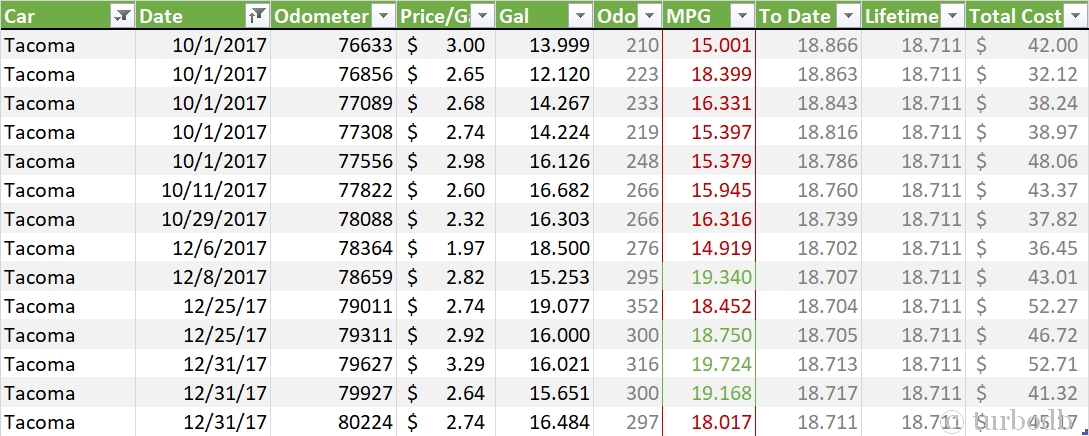
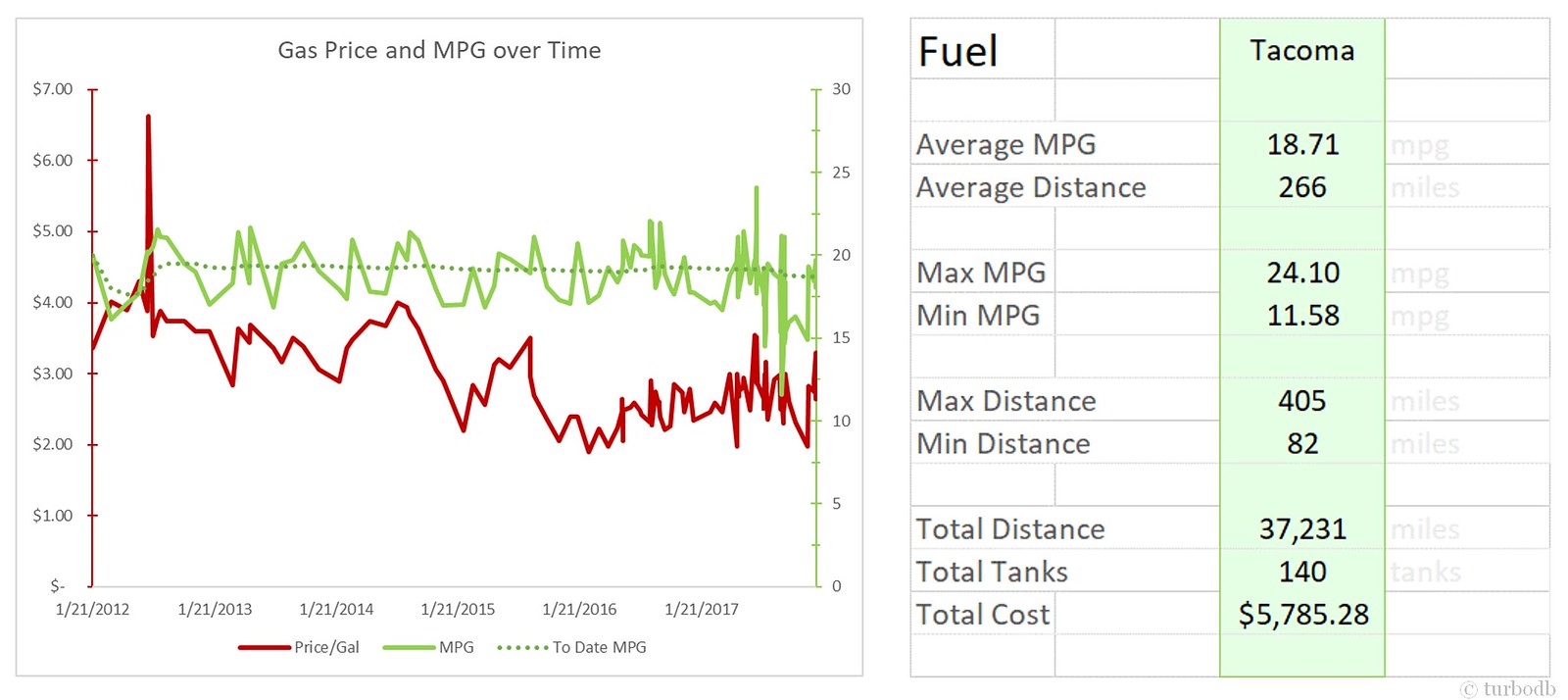
Why vehicles have to lie
When a vehicle is manufactured, there are a lot of components that go into the drive train - engine and transmission revolutions, gearing (and thus rotation) of the diffs, size of the tires - all of these things have to be taken into account when calculating speed and distance.

Some, of course, are more "important" than others when calculating speed/distance travelled - engine RPM for instance varies per gear, so using it to determine speed/distance is not a reasonable idea.
Of course, vehicles take all of these variables into account when displaying speed/distance on the speedometer and odometer. And then they lie. Because they have to - there are too many variables not to.
The simplest piece of this puzzle: tires
I think it's pretty intuitive that a smaller tire would rotate more times in a mile than a larger tire - if you were to lay them flat on the ground, the smaller tire is "shorter" because the circumference is shorter.

Therefore, everything else on the truck being the same, when you have a smaller tire, it rotates more times, so the car thinks it is going faster and further - the tire is spinning more, which means the differential is as well, so the transfer case is too…and the speedo gear reads all that and tells the speedometer to tell the driver something like:
speedometerDamn dude, you're going 80 miles per hour.
…and correspondingly, the odometer adds 80 miles to your vehicle's total mileage every hour that the wheels turn at that speed.
So what happens if you change tires? Well, if you change to bigger tires, they suddenly don't have to rotate quite as fast in order to go the same distance in the same amount of time. Ditto with the other parts of the drive train. So, accordingly, the speedo gear changes it's tune:
speedometerPush the skinny pedal gramps, you're going 59 miles per hour.
Let's make the example a bit more concrete by looking at two real-world tires that are theoretically the same, and that just happen to be stock size tires for a first gen Tacoma:
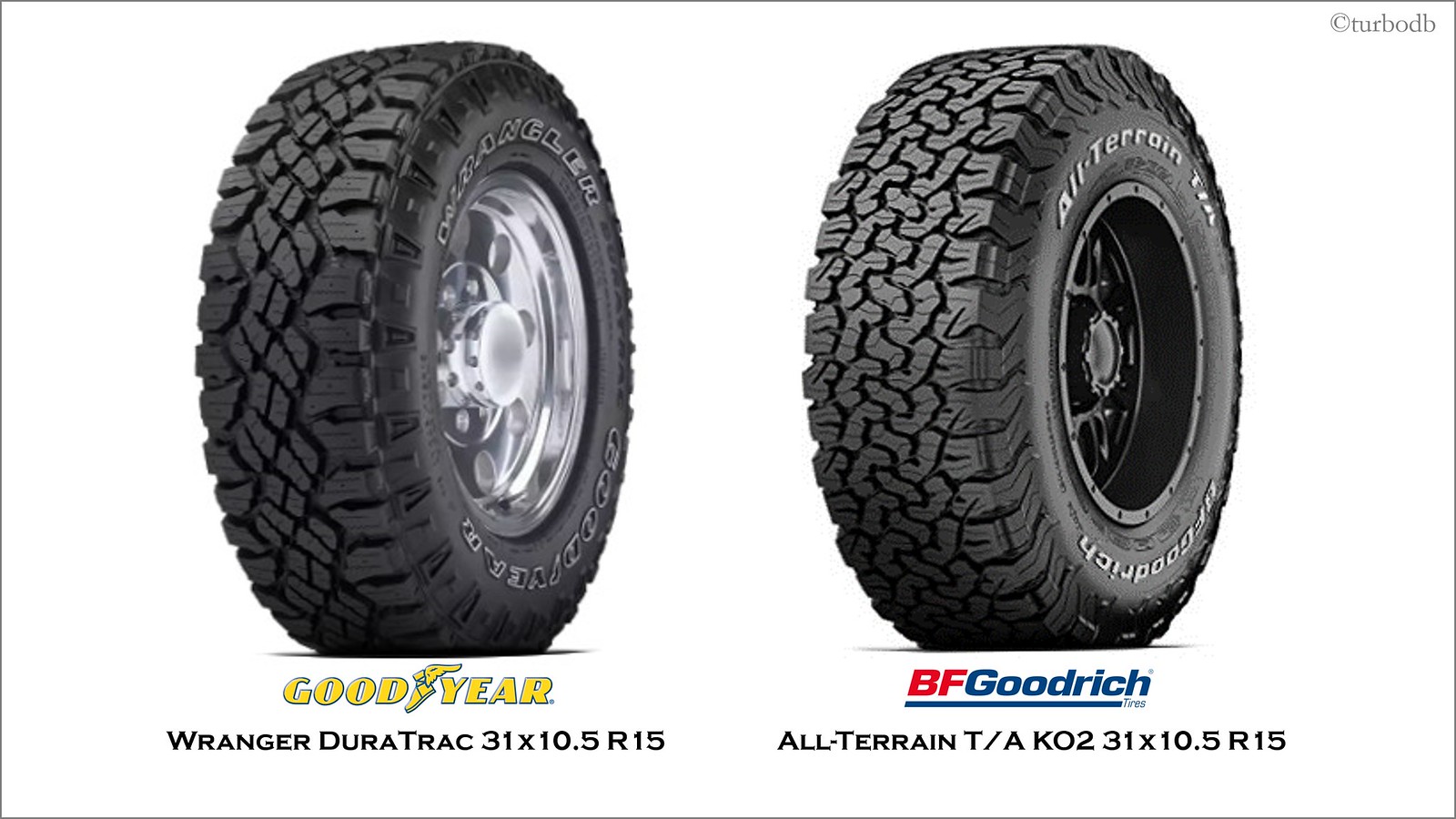
Goodyear Wrangler Duratrac 31 x 10.5 R15
While these tires are listed as 31" tires, their circumference is actually 30.8", which means that in 1 mile, they rotate 654.81 times (when new - as they wear down, they rotate slightly more, obviously).
BFGoodrich All-Terrain T/A KO2 31 x 10.5 R15
These too are listed as 31" tires, but their new diameter is a measly 30.5", which means that in a mile they rotate 661.25 times - 6.44 extra rotations as compared to the Duratracs. Doesn't seem like much, but those 6 rotations per mile add up to a 2.95 mile difference per tank (assuming you go 300 miles on a tank) - so they'd register that you went 302.95 miles

Now, let's say that you fill up 16 gallons for that tank. Your MPG would be:
- Duratracs: 300 miles / 16 gallons = 18.75 MPG
- KO2s: 302.95 miles / 16 gallons = 18.93 MPG
So clearly, even with the "same size" tire, your odometer is lying to you. Once you put significantly bigger tires on, the result changes again, and more dramatically:
Cooper Discoverer ST Maxx 255/85R16
These tires are 33" tires with an actual diameter of 33.1", which means you get 609.29 rotations in a mile. And when you work out the math for that, you end up with 35.48 fewer rotations and ultimately 17.47 fewer miles on your odometer. That's good from one perspective (total mileage on your vehicle) but your gas mileage will look like shit compared to the smaller tires - 282.53 miles / 16 gallons = 17.65 MPG.
The other common variable: differential gears
Just like changing tire size can affect your vehicles interpretation of its speed and distance travelled, so can changing your differential gears. As you increase the gear ratio, you are increasing the number of times that the transfer case (and drive shafts) have to spin in order to rotate a tire one time. Conceptually, think of it like this:
- 4.10 gear ratio means that the transfer case/drive shaft turns 4.1 times to rotate a given tire size tires once
- 4.88 gear ratio means that the transfer case/drive shaft has to turn 4.88 times for a single tire rotation
That means that increasing gear ratio is like decreasing tire size - the transfer case is spinning more times in order to go the same distance. And when the transfer case completes more revolutions in the same time span, the speedo gear interprets that as "going faster." In fact, for a given tire size, 4.88 gears will read ~16% faster (and ~16% more miles).
How Toyota deals with these differences
The simple answer is that they don’t - at least, not by default. They setup our trucks to be "sort of close" in their stock configuration, and then leave it to us to make sure we compensate for any modifications we might make.
How we can determine the extent of the lie?
There's only one way to figure out how much your speedometer and odometer are lying to you, and : you need to use a GPS that tells you your current speed. Then, you need to travel at a reasonably constant speed (highway speeds are most convenient) and compare your speedometer speed to the GPS speed.

If the speedometer reads slower than the GPS, congratulations - your odometer mileage reads fewer miles than you've actually put on your vehicle! Maybe it's time to sell that low-mileage beauty.
For most, the speedometer will read faster than the GPS, which of course means that your odometer has more miles on it than your vehicle has actually been driven. How much you ask? Well, we can calculate that with the following formulas:
Update December 2023
The formulas here are theoretically correct, if the speedometer and odometer are calibrated to match each other. That is, if the speedometer is calibrated to show 60mph when the odometer increases exactly one mile in a minute of travel. However, this isn't what Toyota has done for 1st gen Tacomas; see the link in the update below.

and

So, if over the life of your vehicle, your speedometer has read 65 MPH when the GPS reads 61 MPH, and your odometer has 80,000 miles on it, then your % error is 6.25%, and your actual mileage is 75,040 miles.
With a stock first gen Tacoma, this is pretty normal - so your speedometer and odometer are lying by a little over 6%!
Can we make our trucks stop lying to us?
Yes, sometimes. In the first diagram, an astute reader may have noticed a little piece between the drive train and the speedometer/odometer labelled "speedo gear."

What this little jewel does is compensate for the various rotation speeds downstream (toward the tires) from the transfer case when it relays those speeds to the speedometer and odometer. So, if you get:
- Larger tires - you can get a "smaller" (fewer teeth) speedo gear, so your speedometer doesn't read "low"
- Increased gear ratio - you can get a "larger" (more teeth) gear, so your speedometer doesn’t read "high"
- … etc.
Of course, it's important to take into account all of the modifications you make to your vehicle before changing out the speedo gear. If you install bigger tires and increase your gear ratio, those modifications will (at least partially) offset each other - so the important thing is to check your speedometer speed vs. the GPS speed and calculate your ratio just before you get a new speedo gear.
And, when you get a new gear - at least on a first gen Tacoma - you're looking at about a 3-4% change per tooth on the gear. Stock gear size on a 4WD manual transmission is 31 teeth, so changing to a 33-tooth gear would decrease your speedometer speed by 6-8% at any given actual speed (assuming everything else stayed the same).
So - an example: I recently increased my tire size from 31" to 33" and increased my gear ratio from 4.10 to 4.88. Now, when my speedometer (with a 31-tooth gear) reads 79 MPH, I'm actually travelling at 70 MPH on the GPS - an 11% difference. Therefore, a 33-tooth gear should get me to a point where the speedometer (and odometer) are nearly spot on!
The end of the lies could be in sight!
Do the lies matter?
Not really. I mean, for those of us who like to know the actual speed and mileage of our trucks, even without changing out the speedo gear, we can still calculate those numbers - it's just a bit more work. We have to use the ratio we calculated above to re-calculate MPG for each tank of gas, and overall mileage for the odometer.
For me, that was 214 calculations ('cause I've filled up 214 times). It was complicated slightly by the fact that my truck has had three different ratios over the course of its life:
- 0.94 - most of its life it was 4.10 gears and 31" tires
- 1.00 - for a short time, the speedo and odometer were right on when I had 4.10 gears and 33" tires
- 0.89 - my new ratio, with 4.88 gears and 33" tires
…and basically that means that my actual gas mileage was 6% worse than I thought for most of the life of my truck, right on for a short time, and is now 11% worse than it looks on paper.
Working these formulas into my spreadsheet, I can work out my actual gas mileage - which is generally 1-2 MPG lower than I thought. Hrm :-/
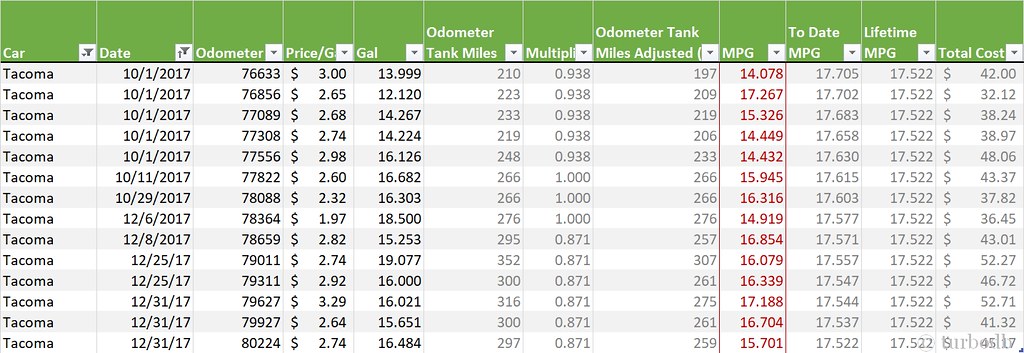
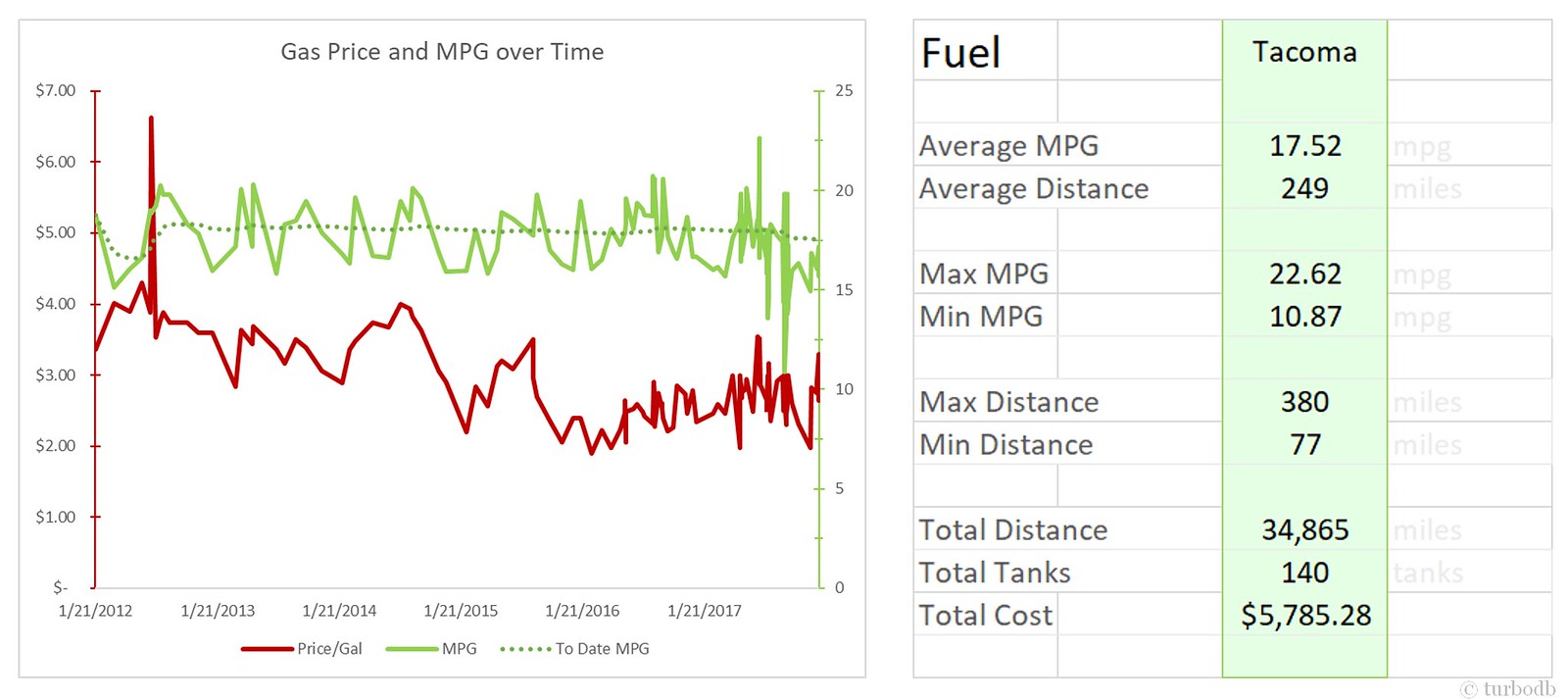
What are the part numbers for these magic speedo gears?
For a first gen Tacoma, the magic part numbers are as follows, depending on your speedometer and transmission type (and I'm not sure whether the automatic can use the 28- and 31-tooth gears - but it seems like they must be interchangeable since the other part numbers are the same).
Electric Speedometer, Automatic Transmission
Electric Speedometer, Manual Transmission
- 28-tooth: 33403-39585 (buy)
- 30-tooth: 33403-39365 (buy)
- 31-tooth: 33403-39345 (buy)
- 32-tooth: 33403-39425 (buy)
- 33-tooth: 33403-39415 (buy)
Cable Speedometer, Automatic or Manual Transmission
- 18-tooth: 33482-39135 (buy)
- 19-tooth: 33482-39025 (buy)
- 20-tooth: 33482-39045 (buy)
- 31-tooth: 33403-39345 (buy)
- 32-tooth: 33403-39425 (buy)
- 33-tooth: 33403-39415 (buy)
Of course, none of these will change your actual gas mileage - that is what it is; but with the right speedo gear, at least your vehicle will have an accurate odometer reading, and it won't be lying to you!
Update May 2023
There's a device on the market that can help with this calibration, and it's both infinitely adjustable and easier to install than the speedo gear. It's a LutzAuto Toyota 3 Wire Speed Sensor Calibrator/Correction Device. With this device, you can calibrate your speedometer/odometer in 0.5% increments to get the perfect reading, with much more accuracy than the 3-4%-per-tooth granularity of a speedo gear, and with no concern that there won't be the "correct" speedo gear for your particular situation.
I've picked one up and cover the installation and configuration here: LutzAuto speed sensor calibrator installation.
I've discovered that you can never have both the speedometer and odometer be accurate at the same time in a 1st gen Tacoma. As such, I recommend focusing on accuracy of the odometer, and leaving the speedometer to be inaccurate (allowing it to read high).
To ensure that your odometer is accurate:
- Find two points that are a long distance - the longer the better, but at least 100 miles - apart, and reset your trip odometer to 0.0.
- Drive from point A to point B and check the value of the trip odometer against the known distance.
- Use the formula: (ending trip odometer - known distance) / (known distance) * 100% to determine how "off" your odometer is.
Once you know how "off" your odometer is, you can use either speedo gears (above) or a calibration device to correct it.
Brilliant. My New SR5 is way off from the factory.... Almost 7%.. any recourse, or is it the cheap tires they put on the truck?
Well, I think 5-7% is about normal for vehicles as they roll off the line. The thinking from a manufacturer is two-fold, I believe. First - and most important to them - they don't want to be liable for that speeding ticket when some class-action suit is brought against them for the speedo being too low and tons of people getting tickets. Second - and perhaps more specifically for trucks - they know we have a tendency to put larger tires on, somewhat negating the "under" speedo.
Really though, as long as you know where your speedo is in relation to your actual speed, that's probably all that matters! 🙂
I have performed two other ways to calculate my ratio.
1) Utilizing the Scangauge to display the speed digitally seems more precise than guessing with the needle on the dash.
2) More precise is to reset the trip odometer and start a GPS recording and run it for a while (on long road trips, I'll do 30+ miles) and then calculate the ratio of truck reported mileage vs GPS recorded mileage.
Yep, those are both great ways to measure the ratio!
Greetings...this page came up while I was chasing a solution to speedometer correction for my new acquisition, '99 4Runner 2WD 4cyl. Auto trans., electric speedometer, stock 225/75/15 tires. Rims looked terrible and little choice in that tire size these days so I opted to go with new 16" rims and the standard optional size for that year / model, 265/70/16 tires. My reference for tire size changes lately has been tiresize.com, good info with numeric and visual size comparisons. These new tires are 8.1% larger circumference, and according to their chart, at a speedometer reading of 70mph I will actually be travelling at 75.7mph. Would very much like to correct this by the most simple and cost effective means possible. I should mention that this vehicle is strictly for city / highway use, no offroading...just my daily driver.
Have been on multiple forums / websites, many suggestions for a fix but most all way too complex and $$$...Scangauge, differential gear swap, GPS...also some purely electronic fixes, SpeedoHealer and Yellow Box. After reading your excellent and very detailed explanation, I am hoping that simply swapping out the speedo gear will get me back to relative accuracy. Especially helpful are your charts showing driven gear tooth count with specific part number, and change % versus tooth count. A couple of questions, if I may...
First I hope you can enlighten me on how a smaller, fewer tooth driven gear will properly engage inside the tranny with the drive gear, since I see no adjustability in its fitment to the tranny case. Does the drive gear only engage when placed into "D"? As per your calculations it would seem that I will require a two-tooth reduction in gear size to compensate for the 8.1% increase in tire size. Which brings my second question...
Are you aware of any reference source online that would tell me what driven gear (tooth count) is likely present in the speedo sensor with the stock configuration I have? I have located the sensor on the tranny case, fairly easy access...so if I must remove it in order to do a tooth count and reinstall twice I will deal with that but prefer not to. I am also considering replacing the entire sensor, this falls into a part # category beginning with 83181-( ), the second set of numbers I assume would designate the driven gear tooth count. Any info there would also be much appreciated.
Your attention to the details you document is quite astounding, your writing skills are excellent as well. Not often do you find these traits in the same individual who must obviously spend a good deal of time out smashing around on adventures in the hinterlands. Just one go around, make the most of it, eh? I look forward to your response, have fun and stay safe out there...
Hi Erik,
First off - thanks for the kind words, and I'm glad you enjoyed the article. Stick around and read some trip reports as well - even if you don't go out into the wild with your 4Runner, there's some beautiful stuff that everyone can appreciate (I hope!) 🙂
Now, to your questions.
First I hope you can enlighten me on how a smaller, fewer tooth driven gear will properly engage inside the tranny with the drive gear, since I see no adjustability in its fitment to the tranny case.
I don't know for sure, but wondered the same since I was installing a larger gear (33- vs 31-tooth). I figured that there must be some sort of spring that pulls the transfer case gears into the speedo gear and so allows some play. I think your idea that it could engage when in drive is also a possibility.
As per your calculations it would seem that I will require a two-tooth reduction in gear size to compensate for the 8.1% increase in tire size. Which brings my second question...
Before getting to your second question, I think I'd determine the percentage in a slightly different way. Find yourself a nice section of reasonably lightly-trafficked highway and get the 4Runner up to 70mph on the speedometer. At the same time, open an app on your phone that tells you how fast you are travelling based on the phone's GPS (any GPS app should do this). Then, you can plug those two numbers into this formula (from above) to figure out the percentage, and you can base the tooth reduction on that.
Are you aware of any reference source online that would tell me what driven gear (tooth count) is likely present in the speedo sensor with the stock configuration I have?
I'm sorry, but I'm not aware of any online reference for this. I'm also not sure if it is the same for a 4Runner as for a 1st gen Tacoma (though as we know, they largely share a drive train).
Here's the approach I'd take in your situation - and unfortunately it may require removal twice...
Not totally ideal, but probably the safest!
Oh - and while I've got you, and after I've done a mediocre job of answering your questions... I'll add this as well - the speedo gear fix worked well for me, but if I were to do it again, I'd probably consider doing it differently. I'd likely purchase a Dakota Digital SGI-100BT Universal Speedometer and Tachometer Interface electronic adapter. I know you've looked at some of these and they are pricey - but for me, the ability to (a) not needing to figure out the current speedo gear size - as well as all the other important bits of information necessary to determine what new gear to purchase, (b) not needing to worry about changing speedo gears in the future and (c) the ability to adjust for different tire sizes in the future - I think those things could be worth the extra price of the electronic converter.
Whatever route you take, I'd love to know what size gear you find in there, and what size you end up installing!
This is exceptional. Thank you